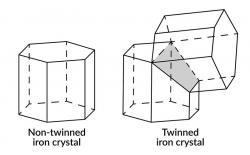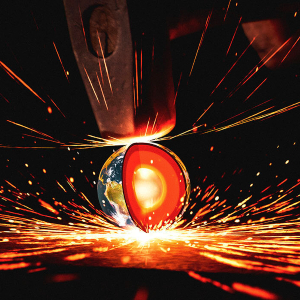The outer core of our planet consists mainly of liquid iron with nickel. It is compressed to 135 to 330 gigapascals, or 1.35 to 3.3 million atmospheres, and heated to 4 to 5 thousand kelvins. Such conditions have recently been mimicked by scientists with powerful lasers and studied the behavior of iron under these conditions.
–
Laboratory games with pressure and temperature. Credit: Greg Stewart / SLAC National Accelerator Laboratory.
–
At a depth of about 2,890 kilometers below our feet is the boundary of the outer core of the planet. It is a massive layer of liquid matter, consisting mainly of iron and nickel, which is about 2,400 kilometers thick. Inside, it hides the inner core, which is solid and represents the center of the planet.
Astrophysical rather than terrestrial conditions prevail in the inner core. The pressure there is around 330 to 360 gigapascals, or 3.3 to 3.6 million atmospheres, while the temperature reaches up to about 5,700 K, which corresponds to the surface of the Sun. Few people would have guessed that we were actually walking in the Sun.

Sébastien Merkel. Kredit: University of Lille.
–
As for the outer core, the conditions are just a little less hellish. The mass is crushed by pressure 135 to 330 gigapascals and the temperature warms it to 4 to 5 thousand kelvins. Such conditions have recently been mimicked in the laboratory by a team led by physicist Sébastien Merkel of the French Université de Lille. Of course, they didn’t do it just for fun. It seeks to understand the depths of the Earth, which are actually more exotic to us than alien planets or stars. In this particular case, they were also interested in the behavior of iron in these conditions, especially its structural deformation.
Under normal conditions, iron crystallizes in a cubic system. At extreme pressures, it forms crystals in a hexagonal (hexagonal) system. Merkel et al. they found out what would happen at even higher pressures and at high temperatures, like in the outer core. The researchers went to the SLAC National Accelerator Laboratory and worked with two lasers. They fired an optical laser into a microscopic sample of iron, creating outer core conditions, namely, a pressure of 187 gigapascals and a temperature of 4,070 kelvins.
 –
–
Iron crystals under extreme conditions. Twins on the right. Credit. S. Merkel / University of Lille, France.
–
The second and definitely more difficult part was to measure the atomic structure of the iron thus afflicted. The researchers used a Linac Coherent Light Source (LCLS) X-ray free-electron laser to measure a piece of iron in a billionth of a second. From the resulting images, they found that iron crystals respond to ultra-extreme conditions by crystal twinning, ie the formation of crystals that share part of the surface.
The research results are very interesting for geologists who model the structure and behavior of the depths of the Earth and other cosmic bodies. They are also important for understanding space collisions and other similar phenomena. Some of the models and hypotheses can now be ruled out. For the rest of us, it’s an exotic trip to the extreme reaches that lie deep below us.
Literature
Physical Review Letters 127: 205501.
– .


